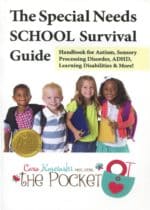HANDWRITING TIPS FOR STUDENTS WITH AUTISM SPECTRUM
Dysgraphia is a deficiency in the ability to write, regardless of the ability to read and not due to intellectual impairment. It is known to be associated with Autism (specifically Asperger Syndrome) and ADHD. Some key facts about children with Dysgraphia:
- Can usually write on some level, but often lack motor coordination.
- May find other fine motor tasks such as tying shoes difficult, though often does not affect all fine motor skills.
- Can lack basic spelling skills (e.g. having difficulties with the letters p, q, b and d).
- Often will write the wrong word when trying to formulate thoughts (on paper).
- Generally emerges when the child is first introduced to writing. The child may make inappropriately sized and spaced letters or write wrong or misspelled words despite thorough instruction.
Once we have learnt to write we can write without having to concentrate or focus. However for these students it takes a HUGE amount of energy and effort to write. Can you imagine how frustrating it must be, knowing what you want to write, how it should look but not having the skills to put it on paper as fast as your brain works! Often children with autism get so tired and frustrated when doing writing tasks, they prefer computers because less fine motor skills are required. However, there are times when using the computer are not appropriate or possible i.e. exams. The other options are a scribe or supporting fine motor skills through pencil grips or getting an Occupational Therapist to help develop fine motor skills.
Writing: Why Use Pencil Grips?
Children need to hold a pencil in a way that provides both stability and mobility. Speed, legibility and endurance of handwriting are influenced by the way a child holds their pencil. Pencil grips help the child maintain a position of stability to allow for efficient mobility and improved handwriting. Two of the most frequently recommended grips are pictured below – the standard pencil grip and the cross-over pencil grip.
Anything we can do to improve fine motor control, build strength and reduce the frustration of the child is essential.
Pencil Toppers are ideal for anyone who chews when writing. Some children (and adults) actually chew when they are thinking or processing.
Handwriting Hints
– Break crayons or pencils in half to help children to develop grasp. Often, kids will hold onto the pencil with all of their fingers if the pencil is too large.
– Add a Popsicle stick or stamp between words to work on spacing.
– Use a highlighter for the top, middle and/or baselines to help children to realise where lines are on the paper. Use a different colour for each line.
– Use a sticker on the top left side of the paper as a reminder of the way the paper should be positioned. Students can then refer to the sticker when reading and writing to make sure they are moving from left to right.
– Use coloured pencils instead of crayons for children who do not like the smell of texture of the crayons
– Listen to the podcast to hear Sue discuss how to use spinning tops to help with handwriting and fine motor skills
– How to Use a Whole Body Approach to Support Fine Motor Skills for Students
– It is thought that 65% of children with autism are left-handed and only 10% of the neurotypical population are left handed. Do you have a left hander? Read page 70 of the Ultimate Guide for 7 strategies
Want more? Check out the Sue Larkey Blog for lots of tips and advice.








 Sorry we no longer ship items outside Australia. Please consider the digital versions of Sue’s Books –
Sorry we no longer ship items outside Australia. Please consider the digital versions of Sue’s Books – 